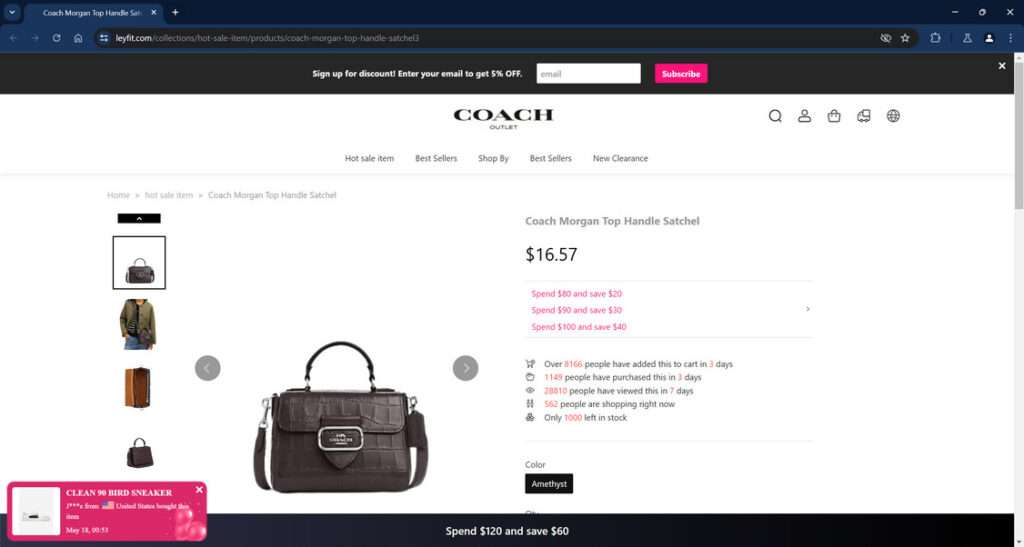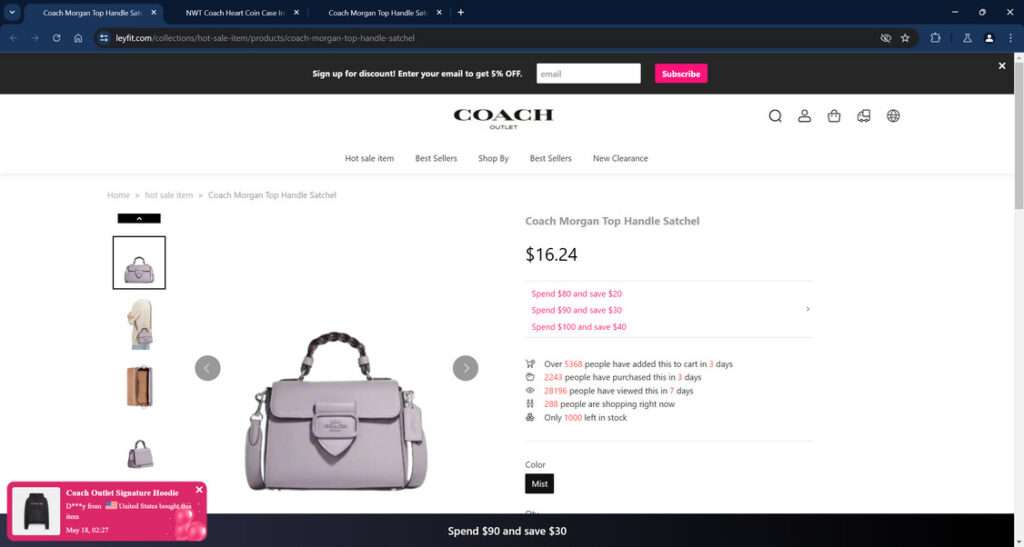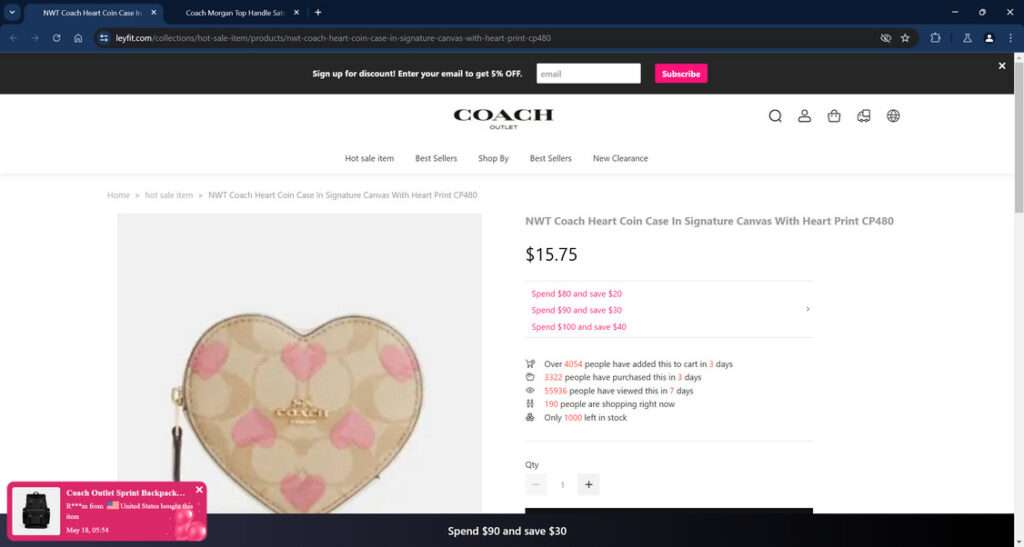Is that “90% off Coach Outlet Sale!” on your social media feed really as luxury as it looks? Maybe not. Savvy shoppers know that while everyone loves a good bargain, unbelievable deals on coveted Coach handbags are likely too good to be true.
Scammers are banking on the prestige of the iconic Coach logo and reputation for quality to lure shoppers into fraudulent sales traps. Don’t let the fake sophistication trip you up. Read on to uncover their crafty tactics, how to avoid being scammed, and ultimately score authentic Coach style and savings from real outlets you can trust.
When high fashion meets digital deceit, protecting your wallet means outsmarting some very fashionable fraudsters at their own game. Let’s dive in to these convincing counterfeit cons and keep our money right where it belongs – far from their fraudulent grasp. The devil is in the details.

This Article Contains:
Overview of the Fake Coach Outlet Scam
The fake Coach outlet scam capitalizes on the popularity and prestige of the Coach fashion brand to deceitfully target shoppers seeking deals on coveted handbags, wallets, and other accessories. By advertising fraudulent blowout sales across social platforms offering Coach items at up to 90% off retail prices, scammers entice bargain hunters to purchase goods through imitation websites that never deliver anything.
Savvy Coach lovers have reported responding to tempting Instagram posts for weekend only “Warehouse Clearance” events with Coach bags starting at just $15. Or Facebook ads shouting “Store Closing Forever – All Items 70% Off!” Once clicking through to the fake sites and entering payment information, victims never receive any products.
The scam persists due to the meticulous mimicry of official Coach branding, website design, product images, and marketing language. From the signature tan Coach logo against a black background to high-resolution photos of popular purses like the Gallery Tote – scammers utilize all the visual details that signal authenticity to Coach fans.
They tout unbelievable yet highly enticing deals for Coach handbag styles like the Ergo Leather Crossbody for $20 rather than $225. Or the Marley Top Handle for $17 rather than $195. Prices seem unbeatable for a luxury designer brand – which is exactly why guarding against such scams is critical.

In addition to website trickery, the scam ads and posts expertly leverage social proof and urgency with:
- Countdown timers running out to buy items “Right Now!”
- Pressure tactics like “Limited Quantities!” and “Today Only!”
- Claims of thousands of orders already placed and items selling out
- Fake comments from users praising the deals
Combined with the temptation of status symbols at bargain prices, these psychological tactics play on shopper emotions and override critical thinking. By the time the credit card bill arrives, the scammers and their fake sites have vanished without a trace.
Some scam red flags to watch for include:
- Coach bags advertised at $15-$25 rather than the $300+ retail price
- Claims of clearance discounts up to 90% off or more
- Limited-time offers only valid for hours or minutes
- Suspicious sales like “Warehouse Liquidation” or “Store Closing Forever”
- Misspellings or odd websites names like “Coach-Outlet-Sale”
- Lack of contact information beyond an email address
- Poor grammar, sentence structure, and typos
With scam sites offering unbeatable deals on Coach exclusives like the coveted Rogue Bag for $18 or the Dreamer Handbag for $12, it’s easy to get hooked by FOMO. But verifying site legitimacy and avoiding unbelievable prices are key to stay protected.
At the end of the day, if it seems too good to be true, it almost always is. The Coach name carries clout scammers will continue attempting to exploit. But savvy shoppers have the power to outwit them and their fake discounts.
How the Fake Coach Outlet Scam Works
Swindlers rely on a precise formula to consistently dupe Coach lovers into relinquishing cash for non-existent products. Here is an in-depth look at each step of the process:
Step 1: Posting Enticing Social Media Ads
Scammers setup Facebook ads, Instagram posts, and TikTok videos advertising huge Coach sales with prices like 70% or 90% off everything. Using stolen Coach images and logos, they tout blowout warehouse events, limited-time flash sales, and store closings with all items dramatically marked down.
The ads target broad demographics likely to be tempted by luxury deals. They leverage urgency and exclusivity with slogans like “Today Only!” and “Limited Inventory!”.
Step 2: Directing Victims to Fake Websites
Clicking the social media ads or links brings users to convincing fake Coach websites made just for the scam. They feature:
- The official Coach logo, fonts, colors, and images
- Sections like “Our Story” mirroring a real Coach site
- High-res product photos with huge sale banners
- A sleek, polished design that perfectly imitates Coach
- Rave customer reviews and satisfaction guarantees
To customers, the sites initially appear indistinguishable from Coach’s real website.
Step 3: Collecting Payment and Personal Information
The fake sites allow victims to browse products, add items to a cart, and enter payment and personal information through an online checkout process.
Various credit cards, Paypal, Venmo, and even crypto payment options are available to maximize chances victims can complete a purchase.
No confirmation emails or shipping updates are ever sent after checkout. But the damage is done – the scammers have user payment details in hand.
Step 4: Vanishing Act
Soon after transaction confirmation, victims find they cannot access the website anymore. Emails to Coach customer support and calls to provided hotline numbers go unanswered.
There is no way to receive ordered items or get refunds, and credit card disputes fail since scammers provide fake business info. Users are left confused and empty-handed.
By completely mimicking a Coach shopping experience and then disappearing, scammers are able to repeatedly trick online shoppers while avoiding consequences. Staying vigilant for red flags is key to avoid being stung.
How To Spot Fake Coach Outlet Websites
With scammers creating increasingly slick fake Coach sites to lure in bargain hunters, how can savvy shoppers recognize fraudulent outlets and protect their money? Watch for these telltale signs when assessing potential Coach deals online:
Sketchy and Misspelled Website Names
Rather than using the official coach.com domain, scammers try to mimic the brand by including “Coach” in the site name. Examples include “CoachHandbagsClearance” or “CoachFactoryOutletStore” or other combinations with the company name.
Other red flags are misspellings like “Coah”, “Coch” or “Coachs” in the URL. Made up words like “officialcoachstores” should also raise suspicions.

Suspicious Domain History
Scam sites using the .com or .store extensions often have recent registration dates within the past 1-2 months. This indicates a fraudulent site set up specifically for the scam rather than a legitimate retail operation.
Mismatching Contact Information
Authentic Coach websites prominently display customer service numbers, store addresses, email contact forms and live chat options.
Scam Coach sites tend to show no contact information or just a suspicious email address. Some may list phone numbers that are non-working or fake. This prevents customers from getting help or refunds.
Unbelievable Discounts
While Coach does offer some sales and outlet discounts, scam sites boast wildly low prices like a $300 purse for $15. With a luxury designer brand, massive 90%+ discounts across all items should immediately raise red flags.
If the prices seem far too good to be true, proceed with extreme caution.
Copied Website Design and Images
To appear authentic, scam sites directly steal product photos, lifestyle images, and branding elements from Coach.com.
Look for pixelated or watermarked images that indicate copying. Layouts mimicking official Coach sites should also set off alarm bells.
Aggressive Sales Tactics and Language
Scam Coach sites lure customers with language implying wild markdowns like:
- “Warehouse Liquidation – Up To 90% Off!”
- “Final Days! All Sales Final!”
- “Going Out Of Business Forever!”
- “Last Chance For Huge Savings!”
These tactics encourage urgency and rush customers to purchase without closer inspection.
When assessing potential Coach deals, keep these red flags in mind. Trust your instincts if a site feels questionable or “off” in any way. And remember – unbelievable bargains on luxury brands are always cause for caution.
Spotting Fake Coach Outlet Deals on Social Media
In addition to shady websites, Coach scammers also rely heavily on Facebook, Instagram and TikTok ads to lure in victims. Be vigilant about these common scam characteristics on each platform:
- Ads for Coach handbags at unrealistic prices like $25 or 90% off
- Posts promoting suspicious Coach warehouse events or store closings
- Fake customer comments praising the deals
- Stolen Coach images used in the ads
- No Facebook page history or reviews outside of scam ads
- High-pressure captions like “Today Only!” and “Almost Sold Out!”
- Instagram accounts using Coach’s name and logos in the username and profile
- Photos of Coach bags followed by claims like “DM to order!”
- Comment sections disabled to prevent warnings
- Link in bio sends to an illegitimate website
- Account with very few or fake-looking followers/engagement
TikTok
- Videos claiming to show inside a Coach outlet with huge sales
- Coach bags displayed while huge discount claims pop up on screen
- Computerized voiceover telling viewers to “Hurry, order now!”
- Link goes to a sketchy lookalike site rather than Coach.com
- Very little engagement on the video outside promoted scam posts
The pattern is unbelievable low prices and high-pressure tactics aimed to overwhelm logic and skepticism. Think critically rather than impulsively when Coach deals seem too good to be true on social channels. Protect yourself by verifying legitimacy first.
What to Do If You Are Scammed
If you fall prey to a fake Coach outlet and purchase items that never arrive, here are important next steps:
- Immediately notify your credit card provider or bank to report the charges as fraudulent so they can quickly be reversed. Provide transaction details.
- Check statements for any signs of identity theft and notify institutions of suspicious activity. Freeze credit reports if needed.
- Report the scam websites and social accounts to the relevant platforms to try to get them shut down to prevent further victimization.
- Avoid any communications claiming to be from Coach customer representatives, investigators etc. regarding your purchase. These could be attempts at further scams.
- Learn to better recognize signs like ridiculous prices or pressure to act fast that indicate fraud. Enhanced awareness of tactics can prevent repeat victimization.
- Only order from coach.com or verified authorized retailers when making future Coach purchases. As the old saying goes – if the Coach deal seems too good to be true, it always is.
Stay on guard, but don’t let scammers deter you from the styles you love. Outsmarting them is the sweetest revenge.
Frequently Asked Questions About Fake Coach Outlet Scams
1. What is the fake Coach outlet scam?
The fake Coach outlet scam involves scammers creating convincing imitation Coach websites and social media ads offering items at huge discounts like 90% off. When customers purchase products, their money is taken but nothing is ever shipped.
2. How do the scammers create such realistic fake sites?
They steal branding elements, product photos, and web design directly from the official Coach website to precisely mimic the look and feel. This tricks shoppers into thinking the sites are legitimate.
3. What are some telltale signs of a fraudulent Coach site?
Red flags include prices that are too good to be true, recent website registration dates, lack of contact information, and threatening language about limited time offers. Authentic Coach sites have reasonable prices and extensive customer service options.
4. Why does Coach merchandise seem so cheap on scam sites?
Scammers know most shoppers would be skeptical of a real Coach handbag costing $15. But prices that seem like unbelievable deals spur impulse purchases – even if the discounts are unrealistic for a luxury brand.
5. How can I identify fake Coach ads on social media?
Watch for limited-time offers with unrealistic prices only available for hours. Also look for fake accounts with little history beyond the scam posts. Authentic Coach ads link directly to Coach.com rather than lookalike sites.
6. I bought a Coach bag on a scam site – what steps should I take?
Immediately call your credit card company to report the charges as fraudulent so they can quickly reverse them and prevent future abuse. Also change account passwords as a precaution.
7. How can I avoid getting scammed when shopping for Coach products?
Only order from Coach.com or verified authorized retailers. Be wary of Coach deals on social media or unfamiliar websites. If it seems too good to be true, proceed with caution rather than impulse.
8. Are there real Coach factory stores or outlet sales?
Yes, Coach does have official retail factory stores and promotes some authorized outlet sales on their website. But they will never advertise huge 90%+ discounts across all items and product lines.
9. What should I do if I receive a cheap counterfeit item?
Notify your bank and credit card company with photos and details comparing the item received to your original order. Emphasize that the product shipped does not match the advertised description.
10. Can I get my money back if I report being scammed?
If you act quickly, your credit card provider can likely reverse any fraudulent charges. But it’s important to regularly check statements for signs of abuse and notify them immediately of any suspicious activity.
The Bottom Line
The fake Coach outlet scam offers stark lessons in the power of scammers to leverage brand trust and appeal to run elaborate cons. By meticulously replicating official Coach websites, social channels, and promotions through sophisticated fraud techniques, they successfully lure customers focused on snagging deals.
This scam will continue adapting to avoid detection, making consumer vigilance and awareness vital. All shoppers must exercise caution and think critically when assessing deals that seem unrealistic. If Coach products are advertised online for prices deeply slashed or through suspicious sales events, it’s likely a scam attempt rather than a miraculous bargain.
But the allure of designer labels and aspirational status makes even savvy shoppers vulnerable to clever social engineering through fake discounts. This scam represents a dangerous collision of digital deceit and human desire that will require increased diligence to overcome. The stakes are high, but protecting our wallets and data is worth winning this game of cat and mouse.










